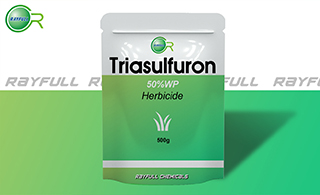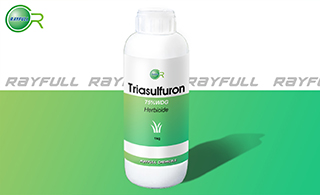Triasulfuron
    ГСұҪ»ЗВЎ ГСұҪ»ЗВЎ
Introduction: Triasulfuron is a selective sulfonylurea herbicide, which is absorbed by the leaves and the roots and is distributed through the plant to the meristems. It inhibits the biosynthesis of essential branched-chain amino acids valine and isoleucine, which prevents cell division and the plant growth is stopped. It is used as a herbicide in the cultivation of cereals (wheat, barley and triticale ) and can be applied before or after the emergence of the weeds.
Common name: Triasulfuron
Another name: Logran; Triasulfuron [ISO]; CGA 131036; EPA Pesticide Chemical Code 128969; etc.
Chemical name: 1-[2-(2-chloroethoxy)phenylsulfonyl]-3-(4-methoxy-6-methyl-1,3,5-triazin-2-yl)urea
Empirical formula: C14H16ClN5O5S
Structural formula:

Mol. Weight: 401.83 g/mol
CAS No.: 82097-50-5
Specifications
Leading Triasulfuron supplier
Triasulfuron 95% TC
Triasulfuron 75% WDG
Triasulfuron 50% WP
Triasulfuron75% WP
Packing:
BULK PACKING
Powder: 25kg/Bag, 25kg/Drum, 50kg/Drum etc.
Liquid: 200L/Drum, 20L/Drum, 10L/Drum etc.
SMALL PACKING
Powder: 1kg/Alu bag, 500g/Alu bag, 200g/Alu bag, 100g/Alu bag, 50g/Alu bag, 15g/Alu bag etc.
Liquid: 5L/Drum, 1L/Bottle, 500ml/Bottle, 250ml/Bottle, 100ml/Bottle, 50ml/Bottle etc.
Customerized packing label
Triasulfuron FAO standard
Professional registration
HAZARDS IDENTIFICATION
Hazard statement(s)
H400 (100%): Very toxic to aquatic life.
H410 (100%): Very toxic to aquatic life with long lasting effects.
Precautionary statement(s)
P273: Avoid release to the environment.
P391: Collect spillage.
P501: Dispose of contents/container to an approved waste disposal plant.
Supplemental Hazard Statements: none.
MAMMALIAN TOXICOLOGY
Acute toxicity: 1) Acute oral LD50 for rats is >5000 a.i.mg/kg. 2) Acute dermal LD50 for rats is >2000 a.i.mg/kg. 3) Acute inhalation toxicity LC50 (4 h) for rats is >5.2 a.i.mg/L. 4) Skin irritation: Non-irritating to skin (rabbits). 5) Eye irritation: Slightly irritating to eyes (rabbits). 6) Skin sensitization for guinea pig: Not sensitising.
NOEL: NOEL (2 y) for rats 32.1 mg/kg b.w. daily, for mice 1.2 mg/kg b.w. daily; (1 y) for dogs 33 mg/kg b.w. daily. Other Not genotoxic.
ADI 0-0.01 mg/kg b.w.
Classification:
WHO Classification: U (Unlikely to present an acute hazard)
EC Risk Classification: N - Dangerous for the environment: R50, R53
US EPA Classification (formulation): III (Caution - Slightly toxic)
ECOTOXICOLOGY
Effect on birds: Acute oral LD50 for Bobwhite quail is >1236 a.i.mg/kg. Effect on fish: Acute LC50 (96 h) for Rainbow trout is >100 a.i.mg/l. Effects on aquatic invertebrates: Acute EC50 (48 h) for Daphnia magna is >100 a.i.mg/l. Effects on algae: Acute 72 hour EC50 for Raphidocelis subcapitata is 0.035 a.i.mg/l. Effects on bees: oral acute 48 hour LD50 is 100 a.i.ҰМg/bee. Effects on earthworms: Acute 14 day LC50 is >1000 a.i.mg/kg.
ENVIRONMENTAL FATE
Animals Mainly excreted in the urine in unchanged form. Plants In wheat, metabolism is by hydroxylation (para to the sulfonyl urea bridge), followed by conjugation of various hydroxy metabolites with glucose. DT50 in forage c. 3 days. In straw and grain, no residues were detectable at harvest time. Soil/Environment The degradation behaviour in soil is determined by the soil type, pH, and especially temperature and moisture content. Field studies with silty loam, clay loam and sandy loam showed a median DT50 19 d, depending on soil type.
Usage: Triasulfuron was introduced by Ciba-Geigy AG (now Syngenta AG). It is a herbicide for annual broad-leaved weed control in cereals and for other weed clearing activities.
Application: Biochemistry Branched chain amino acid synthesis (ALS or AHAS) inhibitor. Acts by inhibiting biosynthesis of the essential amino acids valine and isoleucine, hence stopping cell division and plant growth. Selectivity derives from rapid metabolism in the crop. Metabolic basis of selectivity in sulfonylureas reviewed. Mode of action Selective herbicide, absorbed by the leaves and roots, and rapidly translocated to meristems. Uses Control of broad-leaved weeds pre- and post-emergence in wheat, barley and triticale, at 5-10 g/ha.
| 






